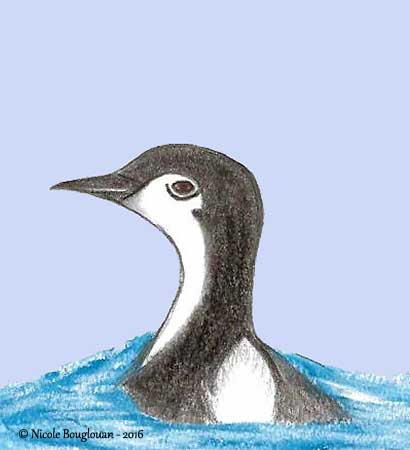
Fr: Guillemot de Xantus
Ang: Guadalupe Murrelet
All: Lummenalk
Esp: Mérgulo de la Guadalupe
Ita: Urietta di Xantus
Nd: Xantus' Alk
Sd: guadalupealka
Text and illustration by Nicole Bouglouan
Sources:
HANDBOOK OF THE BIRDS OF THE WORLD Vol 3 by Josep del Hoyo-Andrew Elliott-Jordi Sargatal - Lynx Edicions - ISBN: 8487334202
OISEAUX DE MER – Guide d’identification de Peter Harrison – Editions Broquet (Canada) – ISBN-10 : 2890004090 – ISBN-13 : 978-2890004092
Wikipedia, the free encyclopaedia
What Bird-The ultimate Bird Guide (Mitchell Waite)
Neotropical Birds – Cornell Lab of Ornithology
BirdFellow – Guadalupe Murrelet
Emperor Ken’s World - Guadalupe Murrelet
Guadalupe Murrelet
Synthliboramphus hypoleucus
Charadriiformes Order – Alcidae Family
INTRODUCTION:
The Guadalupe Murrelet and the Scripps’s Murrelet were formerly two subspecies of Xantus’s Murrelet until 2012. Both are now full species.
The Guadalupe Murrelet breeds on islands off W Baja California and is rarely seen N in Californian waters.
It is threatened by introduced mammalian predators on its breeding islands and by oil pollution at sea. The species is currently classified as Endangered.
DESCRIPTION OF THE BIRD:
Biometrics:
Length: 23-25 cm
Wingspan: 38-40 cm
Weight: 130-185 g
The Guadalupe Murrelet differs from Scripps’s Murrelet in facial pattern and bill shape. This species is a small black and white seabird. The black upperparts are slightly washed grey on top of head, neck, back, wings and tail.
The underparts are white with variable grey/white mottling on flanks.
On the head, the eye is partially surrounded by a white area, making it different from Scripps’s Murrelet. Chin, throat, lores, cheeks and head sides are white.
The black bill is short and slender. The eyes are dark brown. Legs and webbed feet are bluish-grey with blackish webs and claws.

Male and female have similar plumage, but the female is slightly larger than male in culmen, wings and weight (+15g).
The adults in winter plumage have paler greyish-black upperparts, due to worn feathers.
The juvenile resembles adults but it shows some dark bars on flanks.
RANGE:
The Guadalupe Murrelet is found along the W coast of North America. It breeds on islands off the coasts of Baja California and Mexico. It is uncertain off S California.
It winters offshore but probably within its breeding range along the coasts.
HABITAT:
The Guadalupe Murrelet breeds on steep slopes and cliffs on islands, and favours areas with dense vegetal cover.
During winter, it is usually far out to sea, and frequents the deep waters beyond the continental shelf.
CALLS AND SONGS:
The Guadalupe Murrelet produces a rattling trill. It is usually more vocal during the breeding season.
BEHAVIOUR IN THE WILD:
The Guadalupe Murrelet feeds on small fish and crustaceans. It dives and swims underwater in order to pursue aquatic prey. It swims underwater propelled by webbed feet and wings. It feeds often in pairs but rarely in flocks.
The breeding behaviour of the Guadalupe Murrelet is poorly known. Like numerous Alcidae, it is more active at night at colonies. It breeds in small colonies where the low density is probably due to reduced suitable nesting habitat.
It nests in cavities and hollows around tree roots or in rock crevices, close to dense cover. They are usually monogamous with long-term pair-bonds.
The Guadalupe Murrelet disperses offshore after breeding. They remain within their breeding range. They return to the breeding islands by December.
The flight is swift and direct, with rapid wingbeats.
REPRODUCTION OF THIS SPECIES:
The breeding season takes place between late December and July, with egg laying in early spring.
The Guadalupe Murrelet breeds in small colonies. It nests in natural cavities such as caves, rock crevices, abandoned burrows and among tree roots. It does not build a nest but the eggs are laid directly on the ground, protected by dense cover.
The female lays 2 eggs of variable colour, white, blue, green or even dark brown, with markings or not. Both adults share the incubation during 32-34 days. At hatching, the chicks are fully feathered and well-developed. As usual in these species, they remain two days at nest but they are not fed. After two days and at night, both parents take them and the family leaves the nest-site. The adults fly to the sea, whereas the flightless chicks have to find their way to the ocean. They often cross rough terrain or leap from high cliffs into the water below. They find their parents that were waiting for them and calling continuously. Then, the family group swims out to sea. The young depend on adults for several months.
PROTECTION / THREATS / STATUS:
The Guadalupe Murrelet is threatened by introduced mammalian predators on their breeding islands, and especially on Guadalupe Island where cats have caused a significant reduction of the population. They are also vulnerable to fishing nets and oil pollution at sea, and disturbance at colonies.
The global population is estimated to number about 5,000 mature individuals, equating to 7,500 individuals.
The Guadalupe Murrelet is currently classified as Endangered.
This illustration is only provisional, while waiting for a picture of this species.
It nevertheless shows the head pattern that makes this species different.